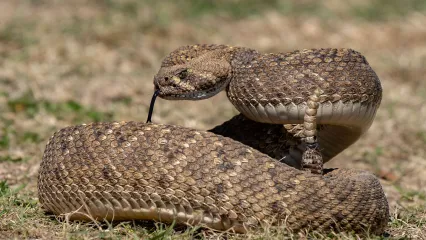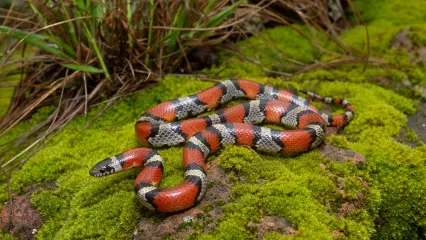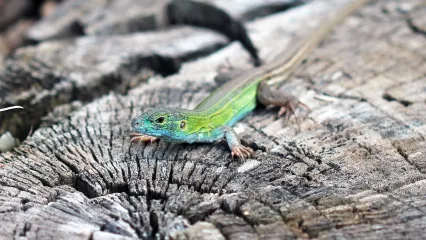
Description
Fearsome or not? Most wildlife species generally hide in the presence of a human or animal larger than themselves. The western diamondback rattlesnake (Crotalus atrox) is an exception to this. Instead of hiding, the diamondback will stand its ground, rattling fearsomely. It is not rattling to protect itself, but to warn intruders of its presence. The diamondback has all the reasons to stand its ground too. Being near the top of the food chain is one, but having one of the most deadly bites in the world gives the snake all the reason to act fearsome.
The western diamondback, despite its very obvious rattle on the tip of its tail, ranges in colors from brown to gray to pinkish, depending on the shade of its habitat. Its spade shaped head is distinguished by two dark stripes, one on each side of its face, which run diagonally, like Zorro's mask, from its eyes to its jaws. The tail is circled by several alternating black and white bands, like the pattern of a raccoon 's tail. These characteristics are very distinct in young snakes, but fade in older snakes.
Hunting primarily at night. using its heat sensing facial pits to sense the warm bodies of its prey, the diamondback will ambush victims along their trails. It also attacks them in their burrows, sometimes striking and swallowing an animal which weighs more than the snake itself. After feeding, the snake can go several weeks before feeding again.
In the fall, the diamondback heads to a community den, generally a cave or rocky recess where they will hibernate for the winter. In colder areas they can be found by the hundreds denning together.
Although the diamondback may seem fearless. it's not invincible. It can fall prey to many species. Eagles, hawks, roadrunners, and other snakes may occasionally prey upon a diamondback. One of the diamondback's main threats is a similar threat to many species, loss of habitat. Even though its habitat range is vast and it preys upon almost any small mammal, the diamondback is still vulnerable to habitat loss.
Conserving the western diamondback may not be popular among those who fear snakes, but it does serve a vital role in the ecosystem. The western diamondback preys primarily upon small rodents , and it plays a key role in keeping rodent populations down. It is estimated that a rattlesnake eats an average of 21 rodents a year, and if an area was to contain 100 rattlesnakes that would account 2,100 rodents falling prey to a rattlesnake.
The western diamondback rattlesnake, may not be your favorite species to see in the wild, but this doesn't mean we can just ignore its significance to the ecosystem . As long as we keep our distance, we may just have the opportunity to sit back and watch one of nature's most feared creatures.
Size
They get to a length of about four feet long.
Habitat
Living in various habitats ranging from desert flats to river bottoms, the western diamondback spans across most of the southwest part of the United States, including most of Oklahoma. The diamondback takes up residence anywhere small mammals such as prairie dogs, rabbits, gophers, ground squirrels, mice and rats can be found.
Life Cycle
Diamondback young do not hatch from eggs, but are born live in late summer. The young are born complete with fangs and venom , armed and dangerous at birth , a good thing since the mother abandons them upon delivery.


